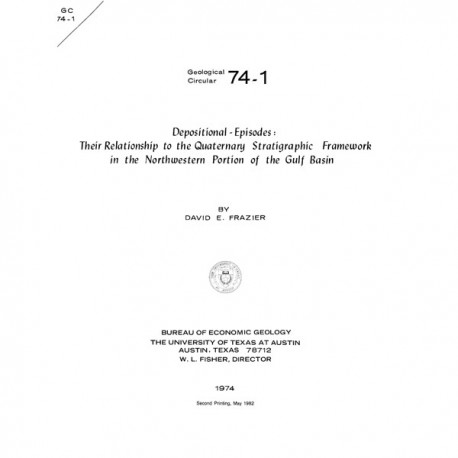Geological Circulars
-
Books & Reports
- Reports of Investigations
- Guidebooks
- Udden Series
- Geological Circulars
- Down To Earth
- Atlases of Major Oil and Gas Reservoirs
- Texas Memorial Museum Publications
- Environmental Geologic Atlas of the Texas Coastal Zone
- Mineral Resource Circulars
- Other Reports
- Seminars and Workshops
- Handbooks
- Submerged Lands of Texas
- Symposia
- Annual Reports
- Open File Reports
-
Maps & Cross Sections
- Thematic Maps
- Miscellaneous Maps, Charts & Sections
- Geologic Atlas of Texas
- STATEMAP Project Maps
- Geologic Quadrangle Maps
- Cross Sections
- Highway Geology Map
- Energy and Mineral Resource Maps
- Shoreline Change and Other Posters
- Wilcox Group, East Texas, Geological / Hydrological Folios
- Bouguer Gravity Atlas of Texas
- River Basin Regional Studies
- Featured Maps
- Posters
- Teachers & the Public
-
Geological Society Publications
- Gulf Coast Association of Geological Societies
- Alabama Geological Society
- Austin Geological Society
- Corpus Christi Geological Society
- Houston Geological Society
- Lafayette Geological Society
- Mississippi Geological Society
- New Orleans Geological Society
- South Texas Geological Society
- GCS SEPM Publications
- Historic BEG & UT Series
Depositional-Episodes: Their Relationship to the Quaternary Stratigraphic Framework in the NW...Gulf Basin
GC7401
A free, digital version of this publication can be found on: Texas ScholarWorks
GC7401. Depositional-Episodes: Their Relationship to the Quaternary Stratigraphic Framework in the Northwestern Portion of the Gulf Basin, by D. E. Frazier. 28 p., 18 figs., 3 tables, 1974. ISSN: 0082-3309. Print.
To purchase this publication as a PDF download, please order GC7401D.
ABSTRACT
The stratigraphic record yields evidence that each episode of clastic silicate deposition has been of limited duration and that each has been preceded and followed by a significant hiatus. Evidence for alternations of deposition and nondeposition is readily apparent in the landward portions of Pleistocene deposits along the Gulf Coast, due to the glacio-eustatic changes in sea level; evidence of alternations, although elusive, exists also in the basinward portions of these deposits. The concept of depositional-episodes explains the significance and relationship of these alternating conditions throughout the basin.
The strata attributed to each depositional episode are a composite of several discrete facies sequences and are referred to in this paper as a depositional-complex. Each facies-sequence represents either a single delta lobe within a deltaic progression, or one of the several repetitive sequences deposited in an interdeltaic environment.
Each depositional-complex records and defines a depositional-episode and indicates three phases of development. Deposits of the initial phase record a stillstand of the sea during which each of the several rivers entering the basin prograde a succession of delta lobes and interdeltaic facies sequences across the shelf. The second phase of development (which is penecontemporaneous with the first) is recorded by the intercalation of clastic and organic flood-plain deposits which accumulate on the newly formed coastal plain, and by the deep-water hemipelagc basin sediments which are secondarily derived from unstable sediments deposited in the outermost shelf and uppermost slope environments. The terminal phase is evidenced by sediments deposited during a period of instability when a marine transgression either continuously or intermittently forces estuarine conditions on the rivers entering the basin. Throughout the terminal transgression, the finite zone of active deposition adjacent to the shoreline is shifted landward. Basinward of this active zone of deposition, hiatal conditions are imposed and at the instant of maximum transgression, when the depositional-episode is terminated, all points on the hiatal surface are synchronous.
The bounding surfaces of depositional complexes represent natural stratigraphic breaks over the entire basin and are related to hiatal conditions imposed by marine transgressions. Within the Quaternary section, the repetitive alternation of depositional-episodes and significant hiatuses is due to the glacio-eustatic fluctuations of sea level: as a result, worldwide correlations of the Quaternary depositional complexes and hiatal surfaces may be possible.
Keywords: deposition, Quaternary, stratigraphy, sea level, Gulf Coast
CONTENTS
Abstract
Introduction
Sedimentologic principles
Depositional-episodes-Definitions and discussion
Depositional-events and facies-sequences
Depositional-episodes and depositional-complexes
Glacially controlled depositional-episodes
Clastic deposition
River-mouth deposition
Initial deposition of sediments from suspension
Interdeltaic deposition
Major transgressions and significant hiatal surfaces
Progradation across a hiatal surface
Effects of sediment failure along the upper continental slope
Turbidites
"En masse" sediment transport
Summary
Stratigraphic framework
Rock-stratigraphic units
Relationship of depositional-complexes to formations
Conclusions
References
Appendix
Figures
1. Exposed Quaternary deposits in the northwest region of the Gulf of Mexico
2. Depositional-event
3. Depositional-episode
4. Interdeltaic offlap: chenier plain
5. Deltaic offlap--St. Bernard delta complex
6. Deltaic offlap--Plaquemines delta complex
7. Stratigraphic framework of present depositional-complex
8. Delta lobes formed by Mississippi River in the past 6,000 years
9. Deposition during first glacial cycle
10. Succession of offlapping depositional-complexes
11. Glacially controlled depositional-episodes
12. Sediment distribution on the Gulf floor in the vicinity of the Mississippi delta
13. Specific gravity, turbidity, and salinity (o/oo) of water beyond crest of bar at Southwest Pass, Mississippi River
14. Submarine topography of outer shelf off Mississippi birdfoot delta
15. Precision-depth-recorder section from Southwest Pass of the Mississippi River westward
16. Basinward limit of Recent elastic deposition on the continental shelf
17. Relict, transgressive, shoreline sands exposed on the continental shelf- northwestern Gulf of Mexico
18. Sea level during last 40,000 years--Gulf of Mexico
Tables
1. Radiocarbon age determinations pertinent to eustatic sea level fluctuations in the Gulf of Mexico in the past 40,000 years
2. Radiocarbon age determinations pertinent to glacial advances in North America in the past 40,000 years
3. Radiocarbon age determinations pertinent to warming trends in the Gulf of Mexico in the past 30,000 years
Citation
Frazier, D. E., 1974, Depositional-Episodes: Their Relationship to the Quaternary Stratigraphic Framework in the Northwestern Portion of the Gulf Basin: The University of Texas at Austin, Bureau of Economic Geology, Geological Circular 74-1, 28 p.


